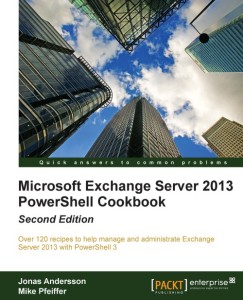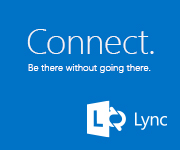Review: Microsoft Exchange Server 2013 PowerShell Cookbook
 I like Exchange. And PowerShell. So, when Packt Publishing asked if I was interested in reviewing their latest book “Microsoft Exchange Server 2013 PowerShell Cookbook”, I jumped at the chance. I was even more excited when I realized that it was written by two heavy hitters, Jonas Andersson and Exchange MCM and Microsoftie Mike Pfeiffer. I’ve known Mike since his days as an Exchange MVP prior to joining Microsoft.
I like Exchange. And PowerShell. So, when Packt Publishing asked if I was interested in reviewing their latest book “Microsoft Exchange Server 2013 PowerShell Cookbook”, I jumped at the chance. I was even more excited when I realized that it was written by two heavy hitters, Jonas Andersson and Exchange MCM and Microsoftie Mike Pfeiffer. I’ve known Mike since his days as an Exchange MVP prior to joining Microsoft.
I had not read any books published by Packt previously, so I was interested to see how this one was put together. What a pleasant surprise. The book, now in its 2nd edition, wastes no time in dispensing some solid PowerShell knowledge with the first chapter, “PowerShell Key Concepts”. If you’re a complete newbie who has been reluctant to take the PowerShell plunge, this chapter has a substantial amount of information to help you get started. In fact, If you read the first chapter, you’ll have an excellent understanding of the basics of PowerShell. Not only is that a great building block for what comes later in the book, but it’s also a great PowerShell primer just by itself. If you’re an experienced coder, the first chapter will help fill in some gaps.
From there we go to common tasks in both PowerShell and Exchange. Some great info there, as well, as we look at many of the things that help tie scripts together including remote sessions, tasks, dealing with .csv files, etc.
From that point on, each subsequent chapter deals with a different area of Exchange, and how PowerShell can make life easier. These are including topics such as mailbox and database management, high availability, and more. Each area is broken down into a specific subject, and includes information broken into several different sections, including “How to do it..”, “How it works..”, “There’s more..”, etc. These start with a simple task, explain the basics, and build on them so that the reader can develop great PowerShell functions and scripts, and understand what’s happening “under the hood”. In reading this book, I can say I’ve learned several different approaches to things that I had not considered previously.
Some things often get left out of Exchange books just due to the complexity of the product. This is often things like compliance. But, oh no – Mike and Jonas dive into this as well, discussing archiving, retention and legal holds, auditing, and more. There’s also a chapter on using the EWS Managed API, which really opens the door to doing all kinds of things by connecting to Exchange via EWS. Just look at what Glenn Scales is doing with EWS.
Chapters break down as follows:
Chapter 1: PowerShell Key Concepts
Chapter 2: Exchange Management Shell Common Tasks
Chapter 3: Managing Recipients
Chapter 4: Managing Mailboxes
Chapter 5: Distribution Groups and Address Lists
Chapter 6: Mailbox Database Management
Chapter 7: Managing Client Access
Chapter 8: Managing Transport Service
Chapter 9: High Availability
Chapter 10: Exchange Security
Chapter 11: Compliance and Audit Logging
Chapter 12: Server Monitoring and Troubleshooting
Chapter 13: Scripting with the Exchange Web Services Managed API
The book also contains some great reference materials in the appendices. A common shell appendix is a great add-on to what’s in the book, especially chapter 1. I probably learned more from this part of the book than anything.
Appendix B delves into query syntaxes – something that can be frustrating if you don’t know the basics and pitfalls. From AND and NOT to date ranges and more. Solid info that should be kept within arms reach.
I have to say, it’s no surprise that I liked this book. Mike and Jonas did a fantastic job keeping the reader engaged. By taking a simple idea and building on it, each example and section helps solidify a solid PowerShell understanding and how it relates to Exchange. Installation, configuration, and administrative tasks are all made substantially easier by the information in this book. The book doesn’t talk over the reader’s head, and the code provided is solid and clean. I can’t recommend this book enough if you’re an Exchange person looking to get into PowerShell to increase your productivity and enhance your career.
The book is available from Packt Publishing in formats including print, ebook, and .pdf, and from Amazon as a printed book, or Kindle download. Buy it! Now!





Follow Me